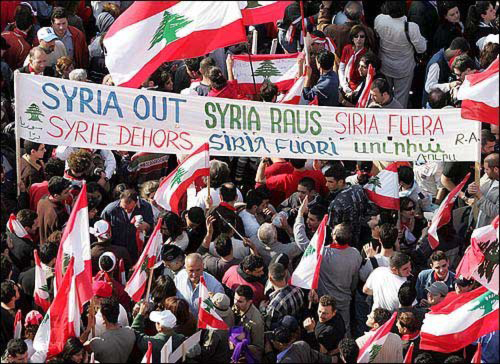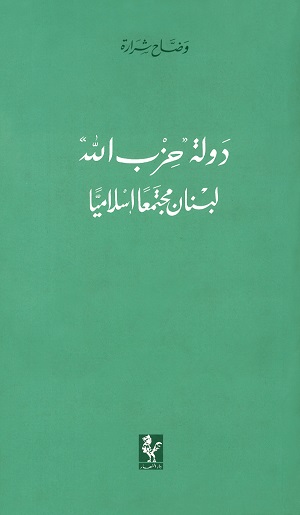The many commemorative events scheduled to take place during 2015 include the tenth anniversaries of Rafic Hariri’s assassination (February 14, 2005) and the launch of what ultimately became the March 8 and March 14 Coalitions. Interestingly, March 8, the backbone of which is represented by Hezbollah, has never taken any particular steps to commemorate that date in March which (not coincidentally) fell on the 42nd anniversary of Syria’s 8 March Revolution, the coup d’état that brought the Ba’ath Party to power. As opposed to our contemporary impression of Hezbollah’s prevalence, March 8 was certainly not the high point in the history of the Assad regime’s presence in Lebanon.
The official reason for the rally held in Beirut on March 8, 2005—in which Nasrallah participated personally—was to “thank Syria” for the “sacrifices” it made during the decade its forces occupied Lebanon. As we know, UNSC resolution 1559, which was passed on September 2, 2004, silently required Syria to withdraw its troops from Lebanon.
By March 3, 2005, just weeks after the assassination of Rafic Hariri and following a meeting between Terje Roed-Larsen (the UN special envoy responsible for monitoring compliance with that resolution), President Bashar al-Assad and his foreign affairs minister, Syria announced that it would finally withdraw from Lebanon. Given the allegiances involved, the particularly festive March 8 rally was intended to convey the notion that Syria’s departure from Lebanon would not be the last word the Lebanese heard from Syria. In contrast, the March 14 rally that was intended initially as a response to the March 8 demonstration snowballed into a huge event that attracted everyone who was not affiliated with Syria and its allies. For instance, some attendees simply wanted to join a counter-demonstration. However, others in the crowd believed fervently that Syria’s withdrawal from Lebanon represented a new beginning for Lebanon, an era that would commence with a deep cleaning process they saw as the logical aftermath of 15 years of Syrian “tutelage,” a period many believed was simply an extension of Lebanon’s 15 years of “war.”
Today, 10 years later, neither camp exudes a particularly rosy outlook—despite the fact that the balance of power is clearly tipping in Hezbollah’s favor.
A symbolic but very telling expression of these conditions is that even the titles of those organizations, “March 8” and “March 14,” are becoming steadily less attractive. Accordingly, their ability to incite mobilization is waning, especially compared to today’s far more brusque sectarian or partisan identity oriented entities. In contemporary parlance, using March 8 and/or March 14 to illustrate Lebanon’s political landscape seems either nostalgic or bordering on intellectual laziness. Of course, the semantic and political dislocation of these two coalitions did not occur overnight; rather, it can be traced back to 2005. More to the point, the key dates in Lebanon that year, March 8 and March 14, pertained to Syria. In 2015, Lebanese references are no less “Syrian” than they were a decade ago, a reality that can be explained from three different perspectives.
1. The influx of Syrian refugees
The estimated million-plus Syrian refugees pose significant short- and medium-term problems for Lebanon. As the fifth year dawns on what began as a popular uprising but devolved into a multifaceted civil conflict that continues to attract all forms of “partisans,” the magnitude of the Syrian refugee presence in Lebanon is simply too great to be referred to as a “problem.” After all, problems are assumed to have discrete solutions. In reality, this steadily expanding community (the high birth rate of which speeds its growth despite Lebanese measures that seek to limit access to the country by new refugees) is likely to remain in Lebanon for an inestimable but definitely lengthy period. Accordingly, the Lebanese and others who profess to care about Lebanese issues may need to become accustomed to the idea that the Syrian refugee community in Lebanon, the lion’s share of which is Sunni, simply cannot be “solved” through humanitarian assistance or containment/restriction measures. Whether we like it or not, a new generation of resentful Syrian refugees is already in the making. Unfortunately, it does not appear that Lebanon has taken counsel from its previous (and ongoing) experiences with the Palestinian refugee population, such that distinct limits exist regarding the capabilities offered by humanitarian assistance and containment/restriction measures.
2. The “Lebanese” involvement in Syria
Lebanese nationals, Shia and Sunni alike, can be counted among the many foreign fighters taking part in the conflict in Syria. At this point, however, it is all but impossible to make an accurate comparison of the number of Lebanese Shia fighting for Hezbollah’s flag and the number of Lebanese Sunni involved under the various jihadi flags. If anything, Hezbollah’s involvement in Syria is proving indisputably that it is an instrumental military factor in that conflict. But while Hezbollah continues to flex its military muscles in Syria and other regional conflicts, it is also contradicting the illusory opinions expressed in countless articles and scholarly papers which held that the organization would continue along the path of “Lebanonization.” The once opaque hierarchical command relationship between Iran and Hezbollah is becoming steadily more visible based on Hezbollah’s increasing involvement in regional conflicts in Syria and elsewhere. Relative to Hebollah’s participation in the Syrian conflict or its broader association with Iran’s grand quest for expansion, the human and financial costs of the organization’s engagement may seem insignificant. From the Lebanese perspective, however, those costs have been staggering—and they are increasing.
Anti-Hezbollah literature commonly describes that organization as a “state within a state,” but even that description falls miserably short of characterizing the situation in today’s version of Lebanon. Instead, it would be more accurate to restore Hezbollah’s previous designation as a “non-state actor” and admit that the organization exists in a non-state under the complaisant eyes of everyone who sees Lebanon’s short-term “stability” as having been preserved by the so-called government’s security and military apparatuses.
The sacrosanct trinity with which Hezbollah categorized its arms as being indistinguishable from those that belonged to state institutions first appeared in the Ministerial Statement released by the Fouad Siniora government. Of note, that administration followed the Doha Agreement, which considered the impact of Hezbollah’s punitive campaign of May 2008 and received a parliamentary vote of confidence on August 12, 2008. The Statement reads in part:
…the right of Lebanon, through its people, army and resistance, to liberate or recover the Shib’a Farms, Kfar Shouba Hills and the Lebanese part of the occupied village of Al Ghajar and to defend Lebanon against any assault and safeguard its right to its water resources, by all legitimate and available means.
Today, words that were once little more than flowery rhetoric have evolved into linear, straightforward and unabashed “cooperation between the Army and the Resistance,” which no one dares to question. After all, is it not that “cooperation” which is responsible for protecting Lebanon and its citizens? From an even more practical perspective, that bilateral cooperation is steadily becoming trilateral—the Lebanese Army, the “Resistance” and the Syrian army—particularly along Lebanon’s eastern border!
3. Lebanon’s Sunnis vs. (“Syrian”) radicalism
Two years ago, Saad Hariri supposedly said that he would not return to Lebanon unless the trip was made via Damascus International Airport. Regardless of the veracity of that comment, the political trajectory of the Future Movement (in its representative capacity for the Lebanese Sunni community and most of the March 14 Coalition) has indeed changed. In fact, it softened from providing unequivocal vocal, financial and allegedly military support to the Syrian revolution to mere whispers about supporting the right of the Syrian people to decide their own future. But that trajectory explains not only where the Future Movement stands relative to the situation in Syria, but also its stand with respect to the community it purports to represent.
Regardless of “the future of the Future” (borrowing from the title of a now-famous article), that shift is an important factor where “the future of the Sunni” community in Lebanon is concerned. A substantial amount of evidence, both politically and security related, confirms that Lebanon’s Sunni community is neither immune to the siren calls for jihad nor is particularly receptive to the Future Movement engaging in “dialogue” with Hezbollah in behalf of that community, especially since the initiative is supposedly intended to ease Sunni/Shia sectarian tensions. All the while, Hezbollah continues to fight in Syria and promises that it will never abandon that battlefield... While it is difficult to conclude that the Syrian conflict is the chief reason for the decline of the Future Movement and the fragmentation of the Lebanese Sunni community, it is certainly not farfetched to assert that it was a primary catalyst in that irreversible process. As proof, the plodding movements of Saudi Arabia, historical patron of the Hariri dynasty and the Future Movement, reflect its understanding of these “new circumstances.” Not only are the Saudis diversifying the contacts they have within Lebanon’s Sunni community, but they are also downgrading the importance of Lebanon: the country is indeed no longer viewed through Saudi eyes as the playground on which it can score regional successes at will.
•
Today, the impact of the younger Assad (and the Assad legacy as a whole) is weaker than ever before. Yet the contemporary version of Syria, where Iran is handily investing blood, cash and diplomacy, can no longer be described accurately as the sole domain of its entrenched ruling regime. Importantly, rather than that of its predecessor, it is this contemporary version of Syria, this new Syrian Time Zone, by which the Lebanese set their clocks. To date, compared to the magnitude of the violence and destruction Syria continues to experience, and despite Lebanon’s geographic proximity, spates of violence and political paralysis, the country has remained relatively “safe.”
Oddly, the Lebanese choose to believe that hidden hands are miraculously responsible for ensuring their protection. Unfortunately, those “hidden hands” are becoming increasingly visible. Indeed, Lebanon’s stability and the safety of its citizens depend ever more on the viability of the ongoing state of exception under which the width and breadth of political life are giving way to a security-oriented approach in which a non-state actor is the state’s protector—or in Lebanon’s case, the remnants of a state.
But how long can that state of exception endure? How long can it resist the pressure being generated within the country’s various “underground” sectors? There are a number of those sectors in the country today, such as:
-the Syrian refugee community,
- the despair that has affected substantial portions of its Sunni community,
- the prevailing state of confusion within its Shia community regarding Hezbollah,
- the steady marginalization of its Christian community,
- a national economy that can only be treated with last-ditch, life-saving approaches
- and the endless political deadlock.
In reality, the list is long and ponderous. Yet if one accepts that today’s version of Lebanon exists in the form of a sophisticated state of exception, then it must also be recalled that Syria owed its stability to just such a “state.”
Clearly, the Lebanon of 2015 still sets its clock according to the “Syrian Time Zone.”
 Print
Print Share
Share
